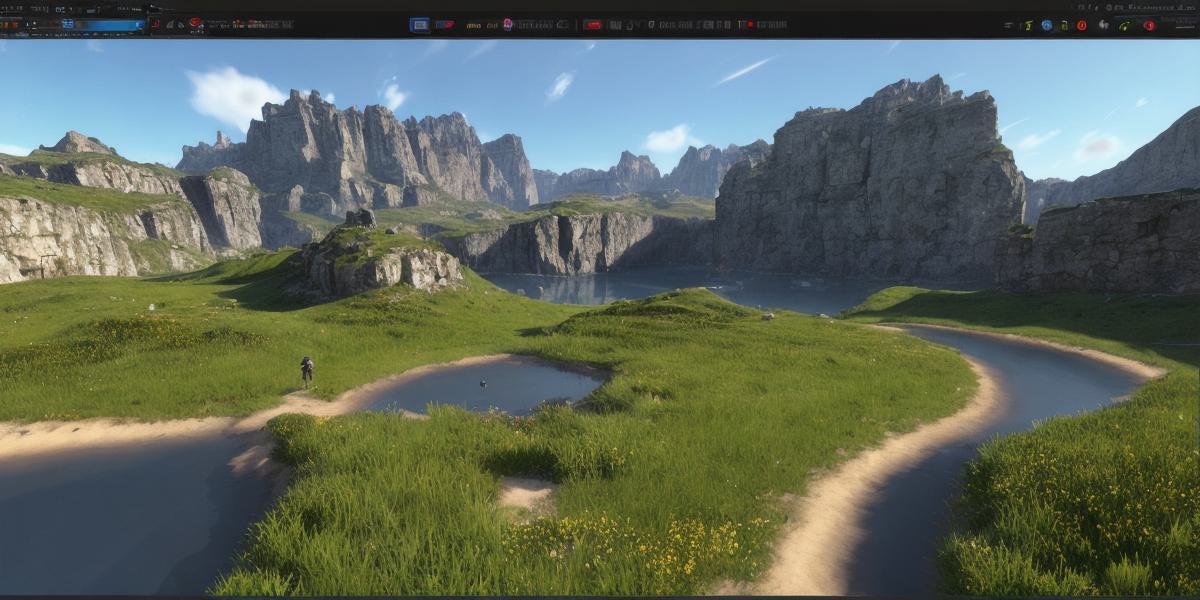In this chapter, we will explore some of the fundamental principles and practices of game design. We will discuss topics such as game mechanics, storytelling, character development, level design, user interface, sound design, and testing. These are some of the key elements that go into creating a great game.
Game Mechanics
Game mechanics refer to the rules and systems that govern how the game is played. They define how players interact with the game world, characters, objects, and enemies. Here are some key principles of game mechanics:
Challenge and Progression
The game should present a challenging but not overwhelming experience for the player. The difficulty should increase gradually as the player progresses through the game, and there should be rewards for successful completion of challenges. This keeps the player engaged and motivated to continue playing.
Feedback
and Rewards
The game should provide feedback to the player on their actions and progress. This can be in the form of visual or audio cues, such as sound effects or music changes. Additionally, there should be rewards for successful completion of challenges, such as points, power-ups, or unlockable content. This provides a sense of accomplishment and encourages the player to continue playing.
Consistency
The game mechanics should be consistent throughout the game. Players should be able to predict how certain actions will work, and the rules should not change suddenly in the middle of the game. This helps players understand the game world and avoid confusion or frustration.
Simplicity
The game mechanics should be simple and easy to understand. Players should be able to learn the basic rules quickly, without needing extensive tutorials or explanations. This makes the game more accessible and enjoyable for new players.
Storytelling in Games
Storytelling is an important aspect of game design. It provides context and meaning to the game world and characters, and helps to create an emotional connection between the player and the game. Here are some key principles of storytelling in games:
Narrative Flow
The narrative should flow smoothly from one event to the next, without any sudden jumps or gaps in the story. This creates a sense of continuity and helps the player understand the world and characters better.
Character Development
Characters should be well-developed and have distinct personalities, motivations, and backstories. As the player progresses through the game, the characters should evolve and change based on their actions and decisions. This creates a sense of emotional investment in the story and the characters.
Choice and Consequence
The game should provide players with choices that have consequences. These choices should affect the outcome of the story and create a sense of agency for the player. This helps to make the game world feel more alive and responsive, and encourages replayability.
Interactive Elements
Interactive elements such as dialogue trees, choice points, and branching narratives can add depth and complexity to the story. These elements allow players to explore different paths through the story and affect the outcome based on their choices. This creates a sense of agency for the player and adds replayability to the game.
Character Development

Character development is an important aspect of game design. It helps to create a sense of attachment between the player and the characters, and makes the game world feel more alive and believable. Here are some key principles of character development:
Personality Traits
Characters should have distinct personality traits that define their behavior, motivations, and actions. These traits should be consistent throughout the game, and should be used to drive the character’s development and growth.
Motivations
Characters should have clear motivations that drive their actions and decisions. These motivations can be personal, emotional, or philosophical, and should be used to create a sense of depth and complexity in the character.
Backstory
Every character should have a backstory that explains their origins, background, and experiences. This provides context for their actions and motivations, and helps to create a sense of realism and believability in the game world.
Evolution and Growth
Characters should evolve and grow throughout the game based on their actions and decisions. They should learn from their mistakes and successes, and develop new skills and abilities as they progress. This creates a sense of progression and achievement for the player, and helps to make the characters feel more alive and dynamic.
Level Design
Level design is an important aspect of game design. It defines how players navigate the game world, and should be designed with the player’s needs and preferences in mind. Here are some key principles of level design:
Navigation
Levels should be easy to navigate, with clear paths and landmarks that help the player orient themselves. The layout should be intuitive and avoid confusing or disorienting the player.
Challenges
Levels should present challenges that are appropriate for the player’s skill level and progress. These challenges can be physical, mental, or emotional, and should be designed to test the player’s abilities and motivations.
Variety
Levels should offer variety in terms of setting, theme, and gameplay mechanics. This keeps the game world feeling fresh and exciting, and prevents the player from getting bored or stagnated.
Replayability
Levels should be designed with replayability in mind, providing multiple paths and choices for the player to explore. This encourages the player to experiment with different strategies and approaches, and creates a sense of ownership and investment in the game world.
User Interface
The user interface (UI) is an important aspect of game design. It provides the player with information about the game world, characters, objects, and enemies, and should be designed with the player’s needs and preferences in mind. Here are some key principles of UI design:
Clarity
The UI should be clear and easy to understand, with concise and straightforward information presented in a logical and organized manner.
Customization
The UI should be customizable, allowing the player to adjust the layout, font size, and other settings to their liking. This makes the game more accessible and enjoyable for new players, and provides a sense of personalization and control for experienced players.
Feedback
The UI should provide feedback to the player on their actions and progress. This can be in the form of visual or audio cues, such as sound effects or music changes. Additionally, there should be rewards for successful completion of challenges, such as points, power-ups, or unlockable content. This provides a sense of accomplishment and encourages the player to continue playing.
Consistency
The UI should be consistent throughout the game, with similar elements and functions presented in a similar manner. This helps the player understand the game world and avoid confusion or frustration.
Sound Design
Sound design is an important aspect of game design. It provides audio cues that enhance the game experience and create an immersive atmosphere. Here are some key principles of sound design:

Ambience
Ambient sounds such as background music, ambient noise, and environmental effects can create a sense of atmosphere and immersion in the game world. These sounds should be designed to blend seamlessly with the gameplay mechanics and not distract from them.
Music and Sound Effects
Music and sound effects should be used to enhance the game experience, providing emotional cues and feedback to the player. These elements should be used strategically and sparingly, and should not overwhelm or detract from the gameplay mechanics.
Localization
Sound design should be localized for different languages and cultures, ensuring that all players can understand and enjoy the audio elements of the game. This helps to create a sense of inclusivity and accessibility for all players.
Testing and Iteration
Testing is an important aspect of game design. It allows developers to identify and fix bugs, improve performance, and ensure that the game is balanced and fun for all players. Here are some key principles of testing and iteration:
Playtesting
Playtesting involves testing the game with real players, who provide feedback on the game mechanics, story, characters, level design, UI, sound design, and other elements of the game. This helps to identify bugs, improve balance, and ensure that the game is enjoyable for all players.
Iterative Development
Iterative development involves making changes to the game based on player feedback and testing results. These changes can be small or large, and can involve adjusting game mechanics, adding new content, or improving existing elements of the game. This process should be repeated until the game is complete and ready for release.
User Research
User research involves gathering information about player preferences, behaviors, and motivations through surveys, interviews, and other methods. This information can be used to inform design decisions and ensure that the game meets the needs and expectations of the target audience.
Chapter 7: Game Development Tools and Technologies
In this chapter, we will explore some of the key tools and technologies used in game development. We will discuss topics such as game engines, programming languages, scripting languages, audio tools, and 3D modeling software.
Game Engines
Game engines are software frameworks that provide a set of tools and technologies for developing games. They include features such as graphics rendering, physics simulation, animation, and input handling. Here are some of the most popular game engines:
Unity
Unity is a cross-platform game engine developed by
Unity
Technologies. It supports 2D and 3D game development for Windows, Mac, Linux, iOS, Android, and web platforms.
Unity
uses C as its primary programming language, but also supports scripting in Boo,
Java
Script, and
C++
.
Unreal Engine
Unreal Engine is a cross-platform game engine developed by Epic Games. It supports 2D and 3D game development for Windows, Mac, Linux, iOS, Android, and web platforms.
Unreal Engine
uses
C++
as its primary programming language, but also supports scripting in
Blueprints Visual Scripting
and
C++
.
Godot
Godot is an open-source cross-platform game engine developed by MonoGame. It supports 2D and 3D game development for Windows, Mac, Linux, iOS, Android, and web platforms.
Godot
uses GDScript as its primary scripting language, but also supports
C++
and
Java
.
Construct
Construct is a cross-platform game engine developed by Scirra. It supports 2D game development for Windows, Mac, iOS, Android, and web platforms.
Construct
uses Haxe as its primary programming language, but also supports scripting in
C++
and
Java
Script.
Programming Languages
Programming languages are used to write the code that controls the behavior of game elements. Here are some of the most commonly used programming languages in game development:
C
C is a high-level programming language developed by Microsoft. It is used as the primary programming language for
Unity
and is also supported by other game engines.
C++
C++ is a high-performance programming language that is used as the primary programming language for many game engines, including
Unreal Engine
and
Godot
.
Java
Java is a popular programming language that is used in game development for mobile and web platforms. It is also supported by some game engines, such as
Construct
.
Python
Python is a high-level scripting language that is often used in game development for prototyping and rapid development. It is also used for creating AI and machine learning algorithms.
Scripting Languages
Scripting languages are used to write the code that controls the behavior of game elements. They are typically interpreted, meaning that they do not need to be compiled into executable code. Here are some of the most commonly used scripting languages in game development:
GDScript
GDScript is a scripting language developed by MonoGame for
Godot
. It is based on
Python
and supports many features of
Python
, such as lists, dictionaries, and functions.
Blueprints Visual Scripting
Blueprints Visual Scripting is a visual scripting language developed by Epic Games for
Unreal Engine
. It allows developers to create game logic without writing any code, using a drag-and-drop interface.
Lua
Lua is a lightweight and embeddable scripting language that is used in many game engines, including Love2D and Corona SDK. It is also used for creating AI and machine learning algorithms.
Audio Tools
Audio tools are used to create and manipulate the audio elements of a game, such as music, sound effects, and voice acting. Here are some of the most commonly used audio tools in game development:
Ableton Live
Ableton Live is a digital audio workstation (DAW) developed by Ableton Technologies. It is used for creating and manipulating music and sound effects in games.
Adobe Audition
Adobe Audition is a professional-grade audio editing software developed by Adobe Systems. It is used for creating and manipulating music, sound effects, and voice acting in games.
FMOD Studio
FMOD Studio is an audio middleware that provides tools for creating and managing the audio elements of a game. It supports many platforms and engines, including
Unity
and
Unreal Engine
.
3D Modeling Software
3D modeling software is used to create the 3D assets of a game, such as characters, objects, and environments. Here are some of the most commonly used 3D modeling software in game development:
Autodesk Maya
Autodesk Maya is a professional-grade 3D modeling and animation software developed by Autodesk. It is used for creating characters, objects, and environments in games.
Blender
Blender is an open-source 3D modeling and animation software that is free to use and distribute. It is used for creating characters, objects, and environments in games.
Substance Painter
Substance Painter is a texture painting software developed by Allegorithmic. It is used for creating detailed textures and materials for 3D models in games.



